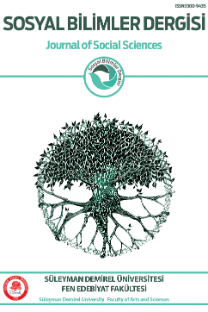Re- creating the doppelganger in peter ackroyd's the casebook of victor frankenstein
Peter ackroydun victor frankensteinin vaka defteri adlı romanında doppelganger
___
ACKROYD, Peter. The House of Doctor Dee. London: Hamish Hamilton, 1993.ACKROYD, Peter. The Casebook of Victor Frankenstein . London: Vintage, 2008.
BÉNYEI, Tamás. Reconsidering the Novels of Peter Ackroyd. British Fiction Today. Ed. Philip Tew and Rod Mengham. New York: Continuum, 2006. 55 -66.
BEVILLE, Maria. Gothic- postmodernism: Voicing the Terrors of Postmodernity. New York: Rodopi, 2009.
CHALUPSKY, Petr. Crime Narratives in Peter Ackroyds Historiographic Metafictions. European Journal of English Studies 14.2 (2010): 121 131.
CHALUPSKY, Petr. Frankenstein as an historical, urban Gothic -psycho-thriller Peter Ackroyds rendering of Mary Shelleys classic in The Casebook of Victor Frankenstein. Ars Aeterna: Who is Afraid to be Afraid? Nitra: Constantine the Philosopher University, 2011. 19 - 34.
CHARNICK, David. Peter Ackroyds Imaginary Projections: A Context for the Creature of The Casebook of Victor Frankenstein . Modern Language Review 108 (2013): 52 67.
FINNEY, Brian. Peter Ackroyd, Postmodernist Play and Chatterton . Twentieth Century Literature 38.2 (1992): 240 -61.
FINNEY, Brian. English Fiction Since 1984: Narrating A Nation . New York: Palgrave Macmillan, 2006.
GENETTE, Gerard. Palimpsests. Lincoln: University of Nebraska Press, 1997.
GENETTE, Gerard. Paratexts: Thresholds of Interpretation. Cambridge: Cambridge University Press, 1997.
GIBSON, Jeremy and Julian Wolfreys. Peter Ackroyd: The Ludic and Labyrinthine Text. London: Macmillan, 2000.
HUTCHEON, Linda. A Poetics of Postmodernism . London: Routledge, 1989.
JACKSON, Rosemary. Fantasy: The Literature of Subversion . New York: Routledge, 1981.
MOTION, Andrew. Frankenstein Frigging Monster. Guardian Review Supplement 13 September 2008: 10.
ONEGA, Susana. Metafiction and Myth in the Novels of Peter Ackroyd. Columbia: Camden House, 1999.
RAFFERTY, Terrence. Raising the Dead. New York Times Book Review 1 November 2009: 17.SHELLEY, Mar y. Frankenstein. Ankara: Engin Yayinevi, 2012.
TEW, Philip and Rod Mengham, ed. British Fiction Today. New York: Continuum, 2006.
WOMACK, Philip. Book Review: The Casebook of Victor Frankenstein. New Humanist 8 September 2008: 48.
- ISSN: 1300-9435
- Yayın Aralığı: 3
- Başlangıç: 1995
- Yayıncı: Süleyman Demirel Üniversitesi, Fen-Edebiyat Fakültesi
Refet Paşa'nın İstanbul'a Girişi ve tıbbiyelilerce karşılanışı
Hayranlık, dostluk ve çıkar üçgeninde Türk- Alman İlişkileri
Sebilürreşad ve Safahat'taki ayetler üzerinden Mehmet Akif'in zihin haritasını okumak
Türkiye müze ve türbelerindeki mumyaların tarihi ve bugünkü durumları
Re- creating the doppelganger in peter ackroyd's the casebook of victor frankenstein
20. Yüzyıl başlarında İstanbul hapishane -i umumi 'de mahkûmların üretim faaliyetleri
Kırım Tatar Türkçesi ve Türkiye Türkçesi arasında yalancı eşdeğerler
